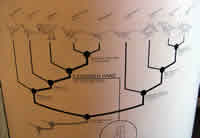I saw this CNN headline (Atlantis Slated to be First Shuttle Retired) and felt a twinge of sadness. I still feel that wondrous feeling when I see photos of a shuttle launch, and I can often shake off a bad mood by remembering that there are humans orbiting the planet right now, performing science experiments and (hopefully) having a good time. In space! It’s so cool.
So, it is a little sad to read that
Atlantis will be the first of NASA’s three space shuttles to be retired, most likely in 2008, as the shuttle program winds down in four years
Four years! I guess I knew it couldn’t go on forever, but it seems like such a short time. I did worry, though, about what (if anything) would replace these ships. What would be the future of human presence in space? I navigated to the NASA website and discovered that the future of human space exploration appears very bright indeed.
First, I’ll quote the clarification in the article of the shuttles’ retirement dates:
The $3 billion shuttle [Atlantis] likely will have four or five more flights to the international space station before retirement.
…
NASA has planned 17 more shuttle flights before the program ends in 2010. The next-generation vehicles are expected to be ready no later than 2014.
Obviously, I hope the flights go well. I was interested to see what was in the pipeline after that, though, so I navigated over to the NASA website and discovered this page, which reads like a Robert Heinlein story:
Before the end of the next decade, NASA astronauts will again explore the surface of the moon. And this time, we’re going to stay, building outposts and paving the way for eventual journeys to Mars and beyond. There are echoes of the iconic images of the past, but it won’t be your grandfather’s moon shot.
How bold! The website is full of renderings of what all the vehicles and bases might look like. It is very, very optimistic, e.g. this description of the program in 2018:
With a minimum of two lunar missions per year, momentum will build quickly toward a permanent outpost. Crews will stay longer and learn to exploit the moon’s resources, while landers make one way trips to deliver cargo. Eventually, the new system could rotate crews to and from a lunar outpost every six months.
How awesome! Finally, things will be like they were in 2001: A Space Odyssey.
Except, hold the phone. This amazing set of missions will probably be, you know, expensive. Can we afford it? Is it realistic? This sobering article from the BBC has a few depressing details:
To help pay for 16 shuttle missions to the space station, Nasa plans to divert about $2bn (€1.1bn) from its science programmes and another $1.5bn (€0.9bn) from its new lunar venture between now and 2010.
Atlantis, you traitor! It appears that the space shuttles are taking up all the funding for the lunar base, as well as cutting into research. Which science programs will be cut?
Targeted programmes include the Terrestrial Planet Finder, which aims to locate Earth-like worlds around other stars, and a mission to Jupiter’s icy moon Europa, which may harbour a liquid ocean beneath its crust.
Can’t have anyone discovering life out there, can we? Of course not. How fares the lunar lander?
Although Bush called for a return to the Moon as a stepping-stone toward Mars and other Solar System bodies, Nasa’s budget includes funds for just one lunar flight, at a total projected cost of more than $100bn (€60bn).
Just one? I thought we were going to have a permanent base there.
Suffice it to say that the future is up in the air (ha ha), but it can’t hurt to let your representative or senator know how you feel. I know many people think NASA is too expensive, and that we shouldn’t spend such vast amounts of money when many of our citizens live in poverty, and when the world has such needs for assistance. I believe, though, that the exploration of space is one of the only things that can unite the world in a spirit of cooperation, and so I think that a robust space exploration program is one of the best investments we can make.
Certainly better than another war.

 Upstairs in the museum, I noticed this interesting illustration among the exquisitely reconstructed dinosaur skeletons. By Odin’s beard! It’s an evolutionary tree of the descent of the Tetanuran (Three-Fingered Hand) dinosaurs. And, as I verified from the skeleton evidence all around me, it seems awfully clear and valid. It also did not seem immediately threatening to the moral development of the many children around me.
Upstairs in the museum, I noticed this interesting illustration among the exquisitely reconstructed dinosaur skeletons. By Odin’s beard! It’s an evolutionary tree of the descent of the Tetanuran (Three-Fingered Hand) dinosaurs. And, as I verified from the skeleton evidence all around me, it seems awfully clear and valid. It also did not seem immediately threatening to the moral development of the many children around me. I visited the Hall of Marine Mammals, where I saw one of my personal favorites. This fellow was staring out at the busy floor, surrounded by a whole bunch of scientifically accurate and thoroughly evolution-drenched material, and everyone seemed to be okay. Indeed, they seemed to be enjoying themselves. I became more and more confused. I didn’t get why people would object to this stuff.
I visited the Hall of Marine Mammals, where I saw one of my personal favorites. This fellow was staring out at the busy floor, surrounded by a whole bunch of scientifically accurate and thoroughly evolution-drenched material, and everyone seemed to be okay. Indeed, they seemed to be enjoying themselves. I became more and more confused. I didn’t get why people would object to this stuff.